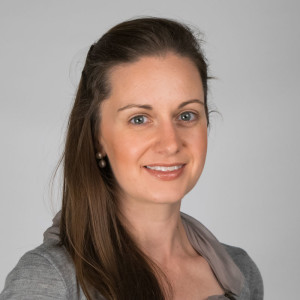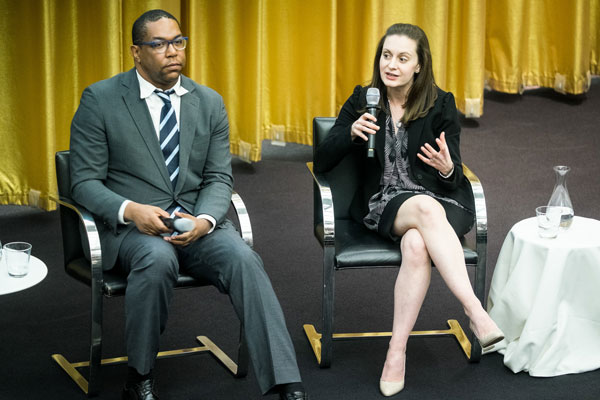Alumni Q&A / Sara Myerson MUP ’11, Director of Planning, Boston Planning & Development Agency
 Sara Myerson’s MUP ’11 experience bridges the public and private spheres, which she touched on as a speaker in the March GSD Alumni Insights Panel “The New Allure of the American City,” alongside fellow U.S. city planners. She began her career at Goldman Sachs and HR&A Advisors. After graduating from the GSD in 2011 with a Master’s in Urban Planning degree, she took on a role back on Wall Street and then as a consultant before joining the city of Boston as the Executive Director of the Office of Olympic Planning. A transition to serving as the Executive Director of Imagine Boston 2030 focused her work on the creation of the first citywide master plan since 1965, which encompasses arts and culture, transportation, development, and the environment. Now as the Director of Planning at Boston Planning and Development Agency (BPDA) formerly the Boston Redevelopment Authority (BRA), Myerson partners with communities to shape a more prosperous and resilient city.
Sara Myerson’s MUP ’11 experience bridges the public and private spheres, which she touched on as a speaker in the March GSD Alumni Insights Panel “The New Allure of the American City,” alongside fellow U.S. city planners. She began her career at Goldman Sachs and HR&A Advisors. After graduating from the GSD in 2011 with a Master’s in Urban Planning degree, she took on a role back on Wall Street and then as a consultant before joining the city of Boston as the Executive Director of the Office of Olympic Planning. A transition to serving as the Executive Director of Imagine Boston 2030 focused her work on the creation of the first citywide master plan since 1965, which encompasses arts and culture, transportation, development, and the environment. Now as the Director of Planning at Boston Planning and Development Agency (BPDA) formerly the Boston Redevelopment Authority (BRA), Myerson partners with communities to shape a more prosperous and resilient city.
In this Q&A, Myerson surveys her career path and offers insights into how the GSD and fellow alumni can be a resource for cities that are grappling with challenges around infrastructure, transportation, climate change, and more.
1. Tell us about your background.
I grew up outside of Boston and developed a love for cities from an early age. Whether it be a weekend father-daughter trip into Boston or a family trip to London, I always found myself captivated by the energy, ingenuity, and intricacies of layered urban landscapes and the people who inhabit them.
My family has been instrumental – often quietly behind the scenes – in many of my academic and professional choices. My dad has a background in accounting, and my mom is an artist. I’ve found that my career path – while not always linear – has consistently been shaped by my attempt to blend the analytical with the creative.
2. Why did you decide to pursue planning as a career?
In 2008, while working on Wall Street, I became interested in the idea that I could blend my passion for cities with my background in finance through place-based impact investing. I decided to pursue planning in an effort to complement my financial skill-set with an understanding of the dynamics shaping the built environment and the power of physical and design solutions for complex urban challenges.
I wanted a school with pedagogy and curriculum that reflect my interdisciplinary interests. At the GSD, I was fortunate to find a place where I could seamlessly move from the studio setting working alongside designers to real estate finance courses alongside business school students.
3. Why did you choose the GSD?
I wanted a school with pedagogy and curriculum that reflect my interdisciplinary interests. At the GSD, I was fortunate to find a place where I could seamlessly move from the studio setting working alongside designers to real estate finance courses alongside business school students. It provided me with a perfect canvas to explore my interest in linking design thinking to a multiple-bottom-line investment thesis.
4. Tell us about your professional career. You have a background in affordable housing and real estate finance. What drove your decision to transition to the public sector to work for city government?
While it has been an incredible experience, I have to admit that my recent transition to the public sector wasn’t entirely planned. After the GSD, I returned to Wall Street to the Goldman Sachs Urban Investment Group where I had an opportunity to work directly in impact investing in real estate development projects and innovative community development initiatives. Wanting to get closer to the projects at an earlier stage, I transitioned to consulting and then to the development side where I worked for a Boston-based non-profit affordable housing developer. I have long believed that it’s important to embrace a non-linear career and in a field with a number of different stakeholders, like real estate, it’s valuable to have experience in the public, private, and non-profit sectors. When the opportunity presented itself to join Mayor [Martin] Walsh’s team and lead the Office of Olympic Planning, I jumped at the chance to have a seat at the table alongside a full array of public, private, and community stakeholders to explore the catalytic potential of planning for a mega-event like the Olympics.
My time working on the Olympic bid was short lived, but I was extremely fortunate to have the chance to stay on with the City and transition into the role of Director of Planning at the Boston Planning & Development Agency (BPDA, formerly BRA). In this role, I have the opportunity to work alongside the community as a steward of our city and built environment. It’s an exciting and challenging time for growing cities like Boston and, as the Director of Planning, I feel lucky to be able to work with the community and administration in shaping our city and laying the foundations for its physical evolution for generations to come.
I think the GSD can be an incredible resource as cities grapple with these challenges – both through academic leadership and by demonstrating the importance of cross-departmental partnership to develop innovative solutions and real-world implementation strategies.

Sara Myerson MUP ’11 with Eric Shaw MUP ’00, director of the DC Office of Planning during “The New Allure of the American City.”
5. Boston is growing at its fastest rate in decades. The BPDA is working on a variety of urban challenges such as outdated and deteriorating infrastructure, transportation concerns, continued waterfront development, and threats posed by climate change and sea-level rise. How would you like to see the GSD engage with the BPDA around this important work? How would you like to see fellow alumni get involved?
In most respects, cities like Boston are incredibly lucky to be experiencing a period of growth and investment, but this growth is certainly not without its strains and challenges. I participated on an alumni panel at the GSD in March, “The New Allure of the American City” where fellow alumni in the New York and DC planning departments shared similar challenges facing their growing cities. I think the GSD can be an incredible resource as cities grapple with these challenges – both through academic leadership and by demonstrating the importance of cross-departmental partnership to develop innovative solutions and real-world implementation strategies. At a time when many communities in growing cities are increasingly hesitant about the pace of change, there is an opportunity for both the GSD and fellow alumni to get involved. One way is to help to lead public discourse about the opportunity of growth and how embracing evolution and change in our cities can be a positive force in positioning us for both short and long term success.
6. What is the most significant thing you learned while at the GSD?
I learned to be a true collaborator and that the strongest teams work together to draw on their diverse areas of expertise.
7. What is your favorite memory of the GSD?
While painful at the time, late nights working together in studio are a favorite – or at least most lasting – memory of the GSD.
8. Tell us about your work/life balance? What occupies you when you are not working?
Much of my time outside of work is spent with my growing family – my husband and I currently live in Charlestown and love spending time around Boston with our two-year-old daughter and miniature Goldendoodle. And we have another baby Myerson on the way! A typical day away from the office usually starts with a morning trip to the Boston Children’s Museum, followed by a stop by the Boston Public Market, lunch on the greenway, a trip to the playground, and cooking dinner back at home.
9. What advice do you have for GSD students and/or alumni?
One of the most valuable aspects of graduate school is the friendships you make and the networks you build. I encourage GSD students and alumni to remember to make the time to continue to nurture these relationships.
10. Looking back, what experiences at Harvard were the most helpful in shaping your career?
My second-year option studio was probably the single most influential experience in my time at Harvard. Having no prior design background, I really stretched myself by opting into an architecture studio focused on London (London: A Particular Proposition.) I had an idea about unlocking property value through a redesign of a social housing site, which could ultimately allow for a financeable renovation of the aging housing stock and long-term cross-subsidization of the affordable housing component. The architecture and urban design students in my studio helped me build a toolkit to explore this concept and blend an examination of a site redesign with real estate finance analysis for my final project. This approach focused on bringing together design solutions with implementation strategies is something I try to incorporate into my work every day.
